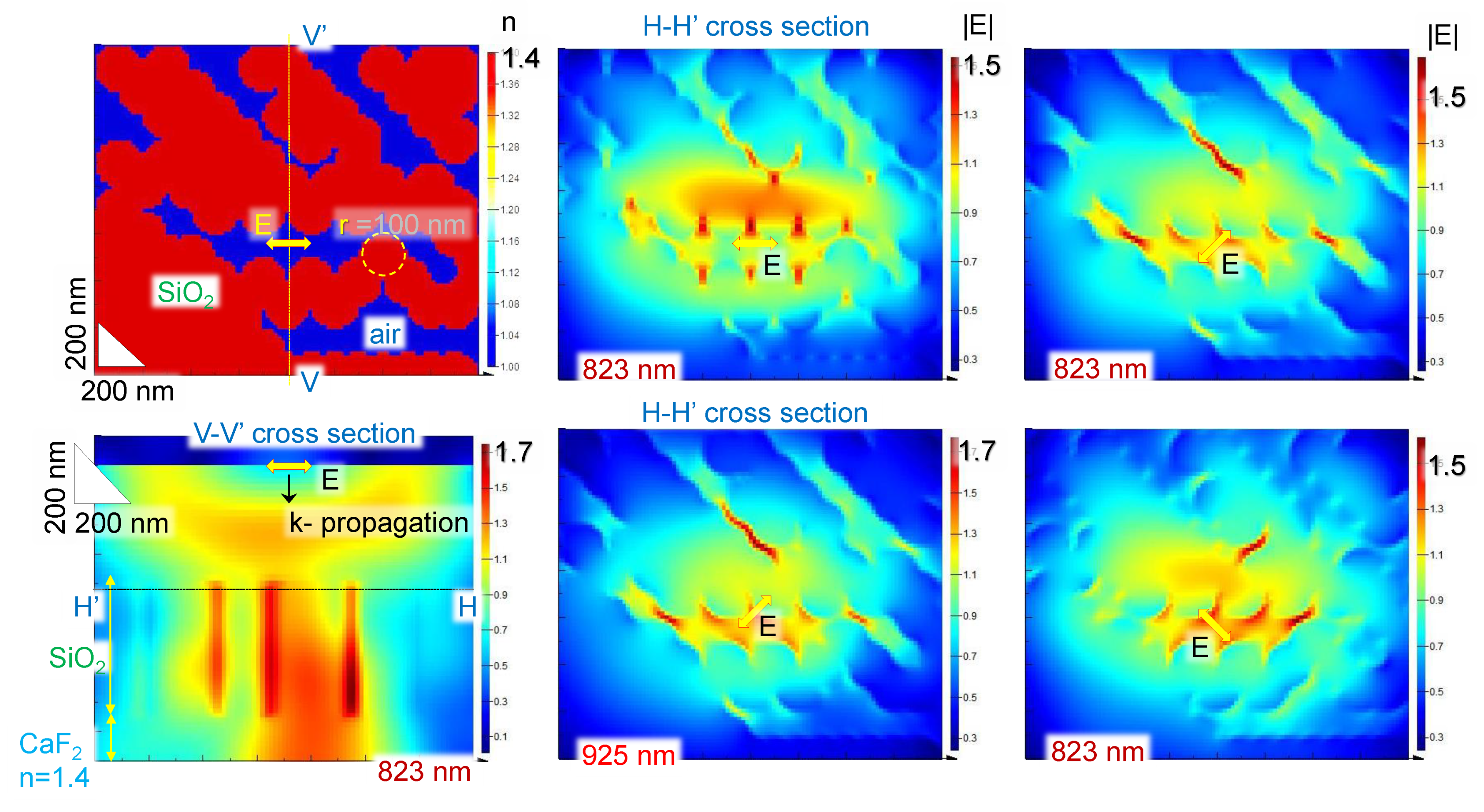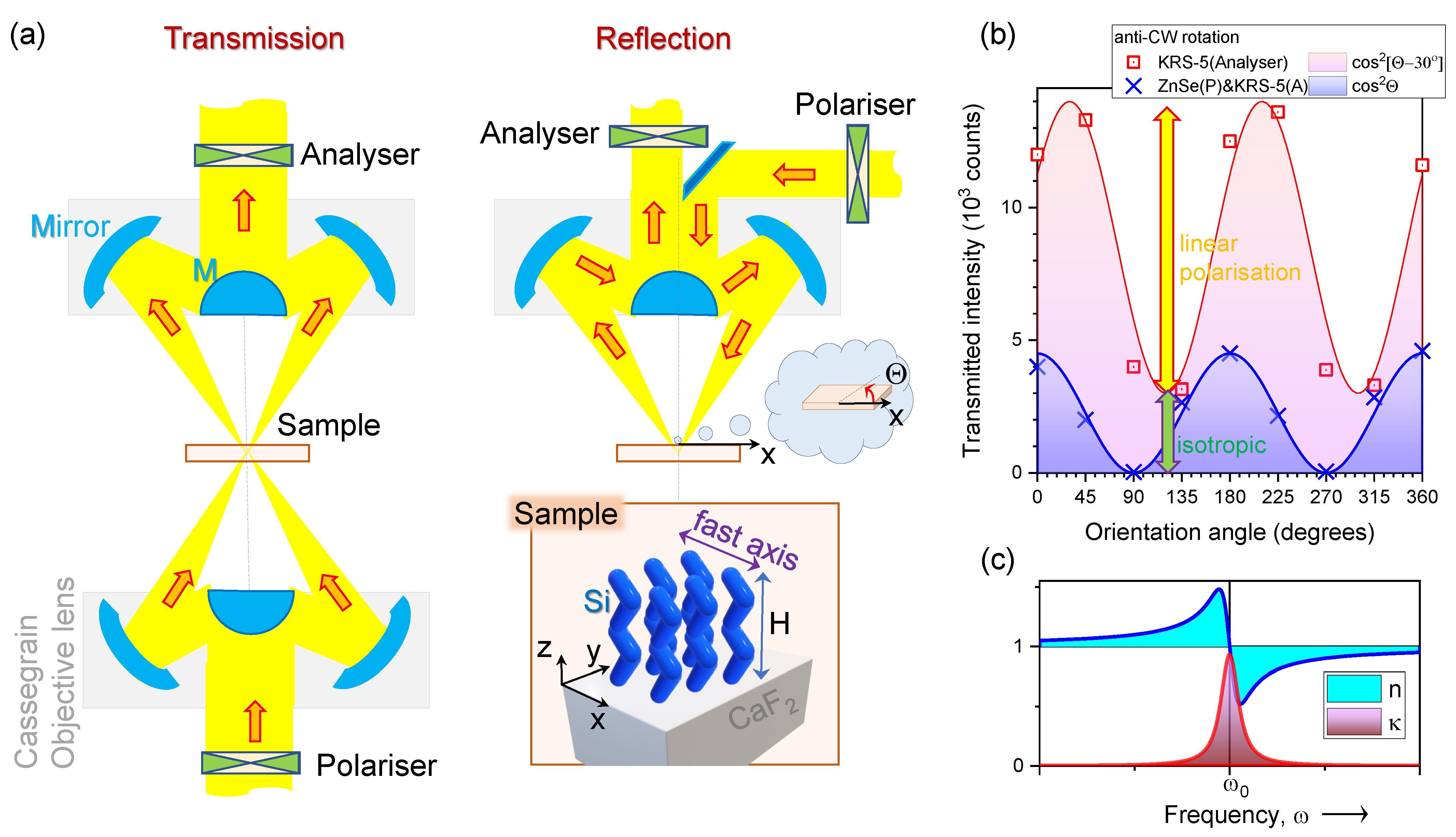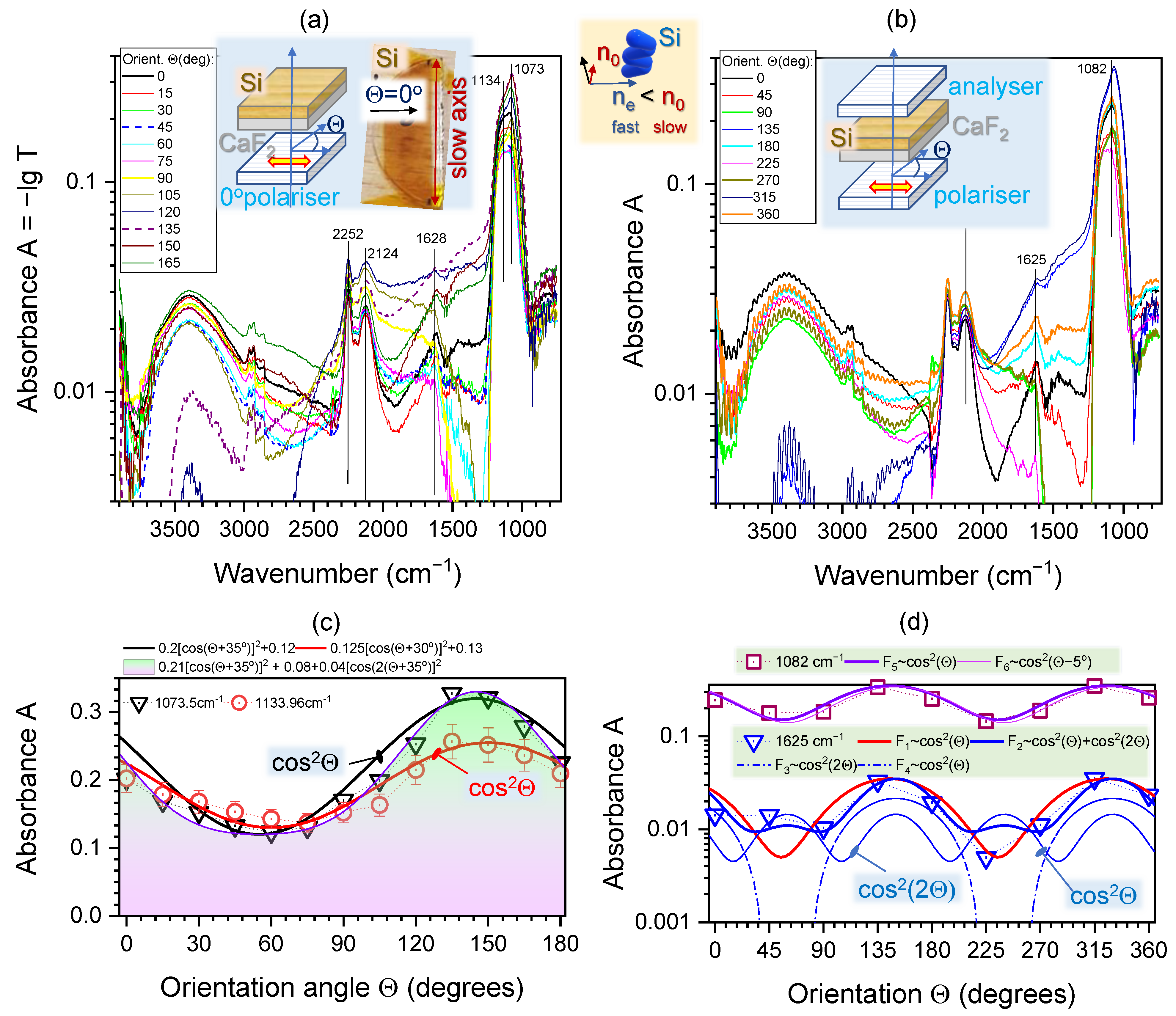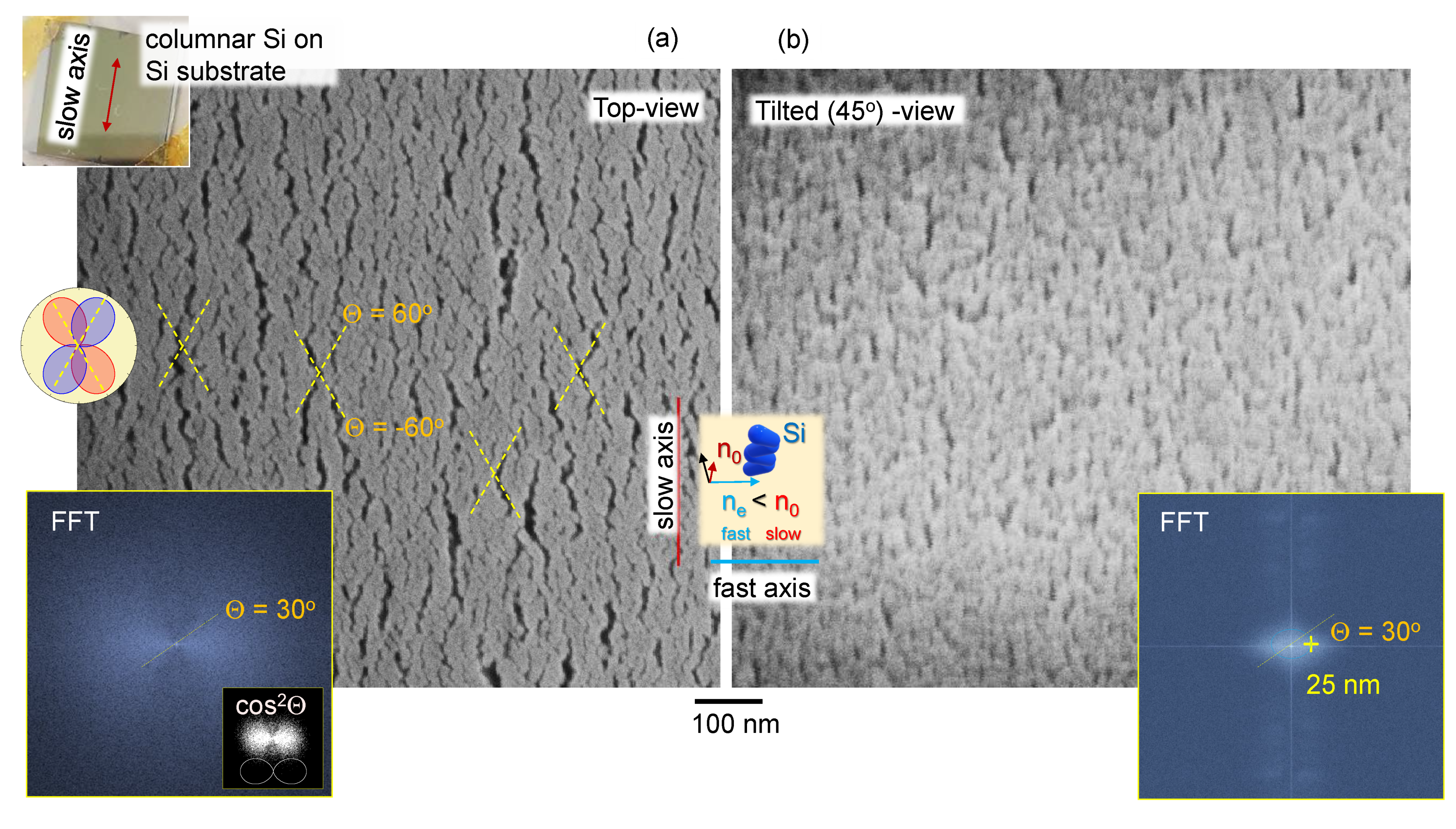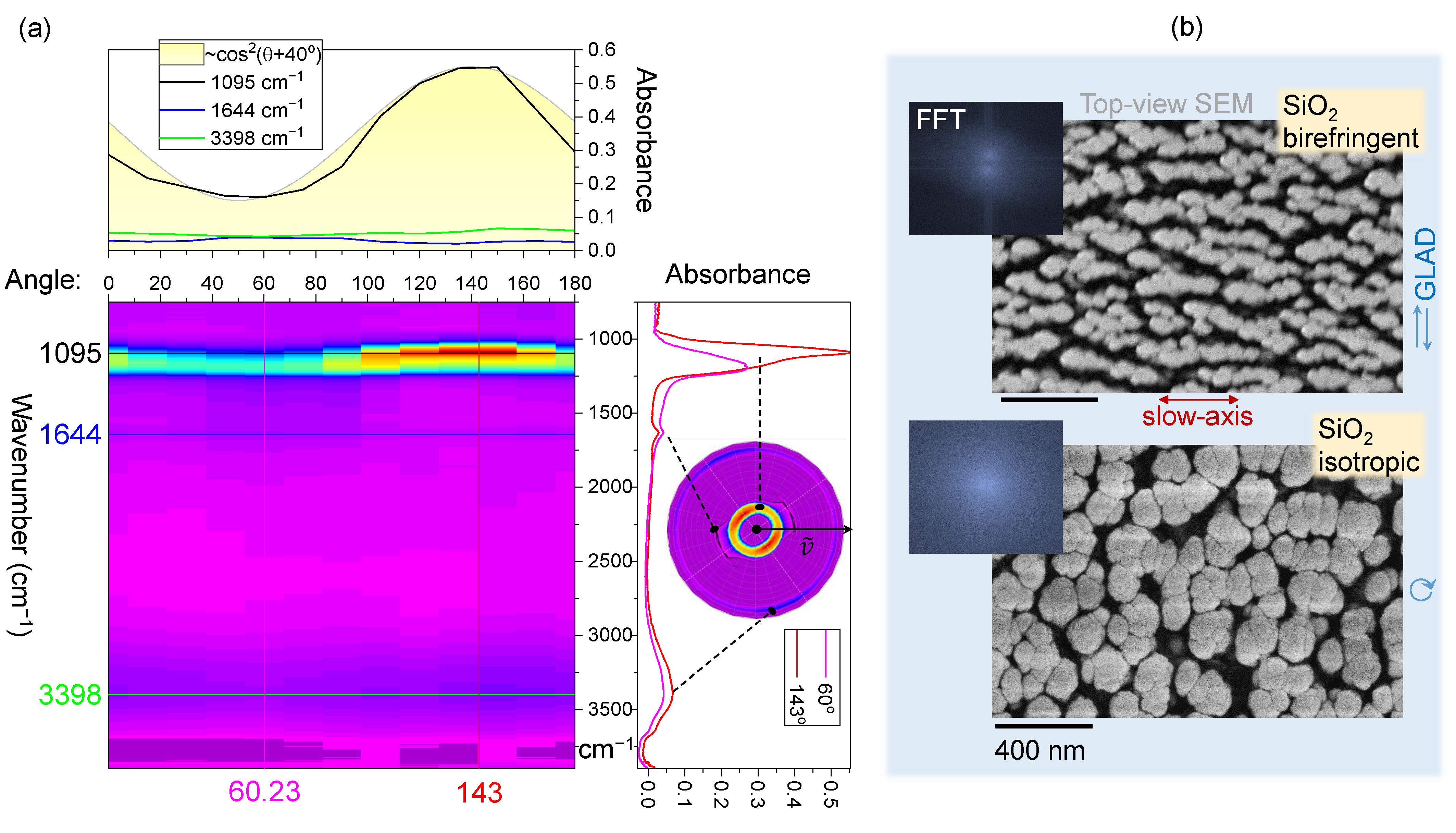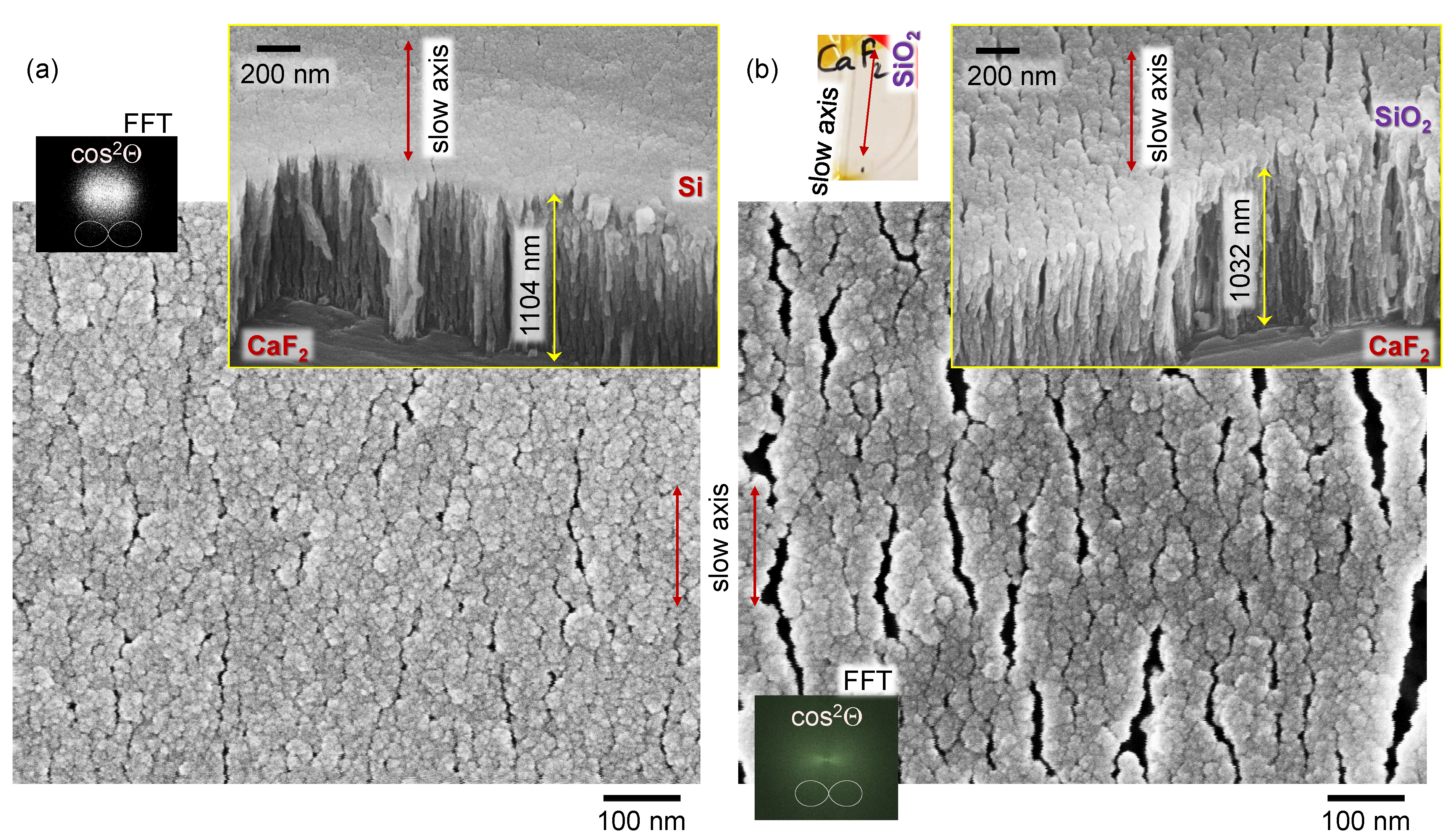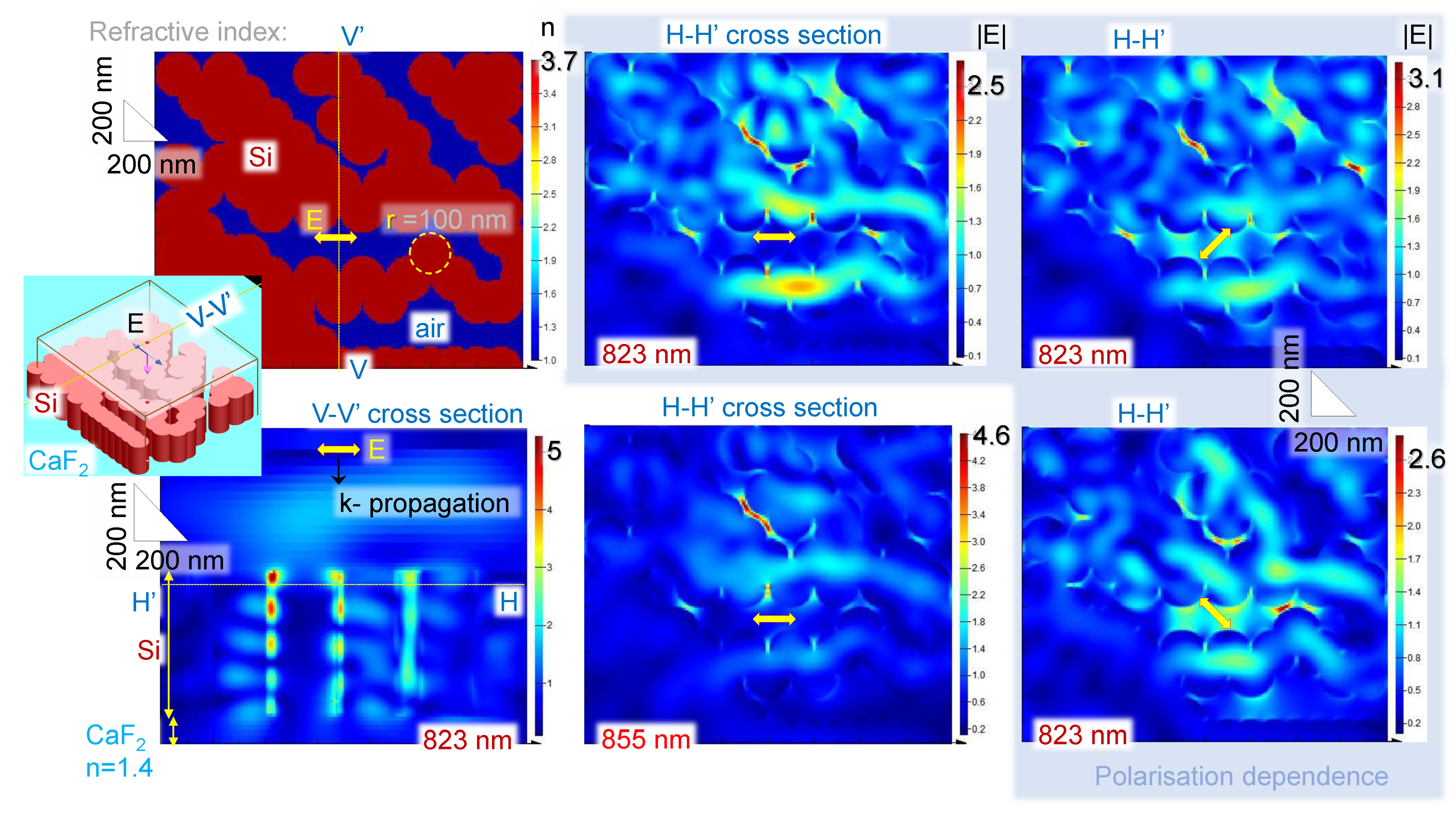1. Introduction
Glancing angle deposition (GLAD) [
1] can be used to make highly anisotropic thin films for light polarisation control, namely waveplates suited for the linear and circular polarisations [
2,
3] and polarisers for zero angle of incidence [
4], by utilising complex arrangements of sample’s tilt and rotation [
5]. It becomes possible to make strongly birefringent thin films by GLAD using optically isotropic Si and SiO
2 materials [
6]. It was recently demonstrated that such films have larger visible and near-infrared (near-IR) laser damage thresholds in J/cm
compared to polished surfaces or coatings made out of the two different materials [
7]. GLAD deposited thin films can also act as an anti-reflection coating [
8,
9]. Recently, numerous investigations have been reported regarding the simulations and analysis of the nanostructure of the GLAD coatings [
10,
11] and constant morphology changes during growth [
12] or in time [
13]. Both silicon and silica have been explored for control of birefringence and structural properties, including porosity and stoichiometry [
14], using GLAD. Anisotropic Si has shown birefringence up to 0.25 in the IR spectral range (∼1500 nm) [
15], while it was lower for silica; however, an augmented optical damage threshold was found in the case of silica in the UV-VIS range [
3]. In both cases, the refractive index anisotropy of a film was created from an amorphous (isotropic) material, which can be applied on virtually any surface, including glass substrates [
4] or laser crystals [
16]. Such films are promising for development of micro-laser systems.
All results indicate that deeper understanding is required in order to fully control the properties of nanostructured thin films, especially when stoichiometry changes [
14]. How such anisotropic films behave at longer wavelengths in mid-IR fingerprint region needs clarification for applications in high-intensity laser optics, as well as in surface enhanced Raman scattering (SERS) sensors [
17]. In addition, the birefringent films and optical elements made by GLAD are porous and possess high surface area. The key question on whether surface defect absorption can compromise the performance of such GLAD coatings due to increased absorption deserves deeper analysis.
The mid-IR spectral range of 400–4000 cm is indispensable for material characterisation. In this study, we used the IR radiation produced by a synchrotron source that offers 100–1000 times higher brightness than that of a thermal IR source commonly used in a laboratory-based FTIR instrument. This highly intense and highly collimated synchrotron-IR beam enhances spectral quality, in terms of signal-to-noise (S/N) ratio, and enables acquisition of high-quality FTIR spectra at diffraction-limited spatial resolution ideal for analysis of these micro-films.
We showed previously [
18] that separate contributions to anisotropy due to birefringence and dichroism related to the real and imaginary parts of the refractive index
, respectively, can be revealed from the angular dependence of transmittance
where the transmitted and incident light intensities are
and
, respectively. The absorbance, i.e., the optical density
(for a negligible reflectance
R). Indeed, an absorbing dipole has minimum and maximum
A (and
T) within an orientation change of
. Transmitted power through a linear polariser (e.g., mesh grid absorber) is given by the Malus law
. However, a change of
T due to birefringence doubles the angular frequency since min-max of
T occurs twice within an orientation change of
. The angular dependence of transmittance
, when reflectance and absorbance are negligible
,
for the crossed (×) polariser–analyser setup, is given by:
where
is the orientation angle;
is the slow or fast axis direction (i.e., the slow axis is usually aligned to the main molecular chain or along a polymer stretch direction);
is the birefringence of the sample/object at the wavelength
, for thickness
d. Hence,
angular dependence, which is double the angular frequency
, rather
for the absorber (Malus law). Following energy conservation, the absorptance
, the optical density
is defined by
, where
R and
T can be directly measured and
with
reflected intensity; accordingly,
.
Here, we reveal optical absorption anisotropy in the mid-IR fingerprinting region of 3D columnar films deposited by GLAD using the polarised synchrotron-IR microspectroscopy. Structural characterisation by scanning electron microscopy (SEM) was used and numerical modeling was applied for qualitative analysis.
2. Results
Polarisation analysis of thin columnar films deposited by GLAD was carried out in transmission
T and reflection
R modes (
Figure 1a) depending on transparency of the substrate in the 600–4000 cm
spectral window (16.7–2.5
m in wavelength). To ensure that the region on the substrate from which the orientational dependence of transmittance
and/or reflectance
was measured is consistent, wire grid KRS-5 (thallium bromo-iodide) and ZnSe polarisers were rotated with a sample at a fixed position. The orientation angle
corresponds to the angle between polariser and sample orientations. This ensured measurement from the very same focal spot, typically ∼17
m in diameter (on the sample).
Figure 1b shows one polariser and crossed polariser–analyser transmission intensity. Due to the linear and isotropic (circularly polarised) contributions of the dipole and edge emission from the synchrotron source, it was not possible to extinguish transmittance with one polariser. With a pair of crossed polariser and analyser, it was possible to reach near-zero transmittance.
The degree of linear polarisation from synchrotron radiation [
20,
21] reaching the beamline is defined by the powers of linear
and isotropic
components, respectively, as
(
Figure 1b). This is consistent with the 22% previously measured for linearly polarised radiation at the THz beamline, which uses the other half of the synchrotron-IR beam extracted by the first IR mirror, with a larger portion of the isotropic emission [
22]. With the strong linearly polarised synchrotron radiation at the Infrared Microspectroscopy (IRM) beamline, polarisation dependence of absorbance and transmittance can be analysed at an enhanced S/N ratio. Orientation of the slit of the first IR mirror defines the orientation of a linearly polarised component, which was along the
x-axis in our experiments.
Polarisation analysis in the mid-IR spectral range can be carried out with the described polariser–analyser setup in direct transmission as well as in attenuated total reflection (ATR) modes [
23]. Less explored polarisation dependencies are at the vicinity of the absorbance bands where the Lorenzian absorption
and dispersion
lineshapes are interrelated [
19] (
Figure 1c).
2.1. Polarised Synchrotron-IR Spectra of Anisotropic Columnar Si Micro-Films
Figure 2a shows polarised synchrotron-IR spectra of 3D columnar Si deposited on an IR-transparent CaF
2 substrate. A single polariser (analyser) was rotated through
in
intervals and changes in spectral features are shown for each orientation
.
Figure 2b shows the same sample, but measured with an aligned polariser–analyser setup. The strongest absorption was found at ∼1100 cm
attributable to Si-O-Si stretching vibration [
24]. A Si-C band at ∼1620 cm
was observed close to the adventitious carbon band at ∼1640 cm
(i.e., C=C stretching mode) [
25]. The doublet peaks centred at 2250 and 2120 cm
are assignable to Si-H and Si-H
2 vibrations, respectively [
26]. Their positions are located adjacent to the CO
2 peaks (∼2330 cm
) [
27], which are recognisable as an atmospheric interference (the reference sample used for background measurement in this study was CaF
2). Due to inherent porosity of 3D columnar Si film, a perfect cancellation of the gaseous CO
2 bands was not achieved, even though samples were held in a nitrogen-purged enclosure throughout the experiment. Distinct CH
3 and CH
2 stretching bands in the 2950–2850 cm
spectral region are identifiable and observed next to the broad -OH stretching band at ∼3400 cm
as a result of the Si-OH structure. Interestingly, there is a similarity of a spectral profile of absorbance between 3D porous columnar Si film deposited by GLAD and 3D porous Si made by electrochemical wet etching of (poly)crystalline Si [
28].
We selected several spectral positions within specific absorption bands of Si-O-Si and some other spectrally distinct locations to investigate anisotropy of birefringence and dichroism at the corresponding wavelengths.
2.2. Orientation Dependence of IR Absorption Bands
In order to measure polarisation dependence of absorbance
, one polariser is required. For measurement of birefringence
, usually a cross-polarisation setup is used and transmittance
(Equation (
1)) is measured. However, such determination of birefringence is not applicable to absorbing samples or at spectral positions close to absorption bands. In the visible spectral range, where most polarisation optical elements are used (
), absorption is not important and optical losses are mostly due to reflection and scattering (related to
rather
). It is possible, however, to determine the dichroism
contribution in the case of polariser–analyser transmission measurement when they are both aligned to the maximum transmittance (‖). This condition is related to the cross-polarisation alignment by simple algebraic expression
(see Equation (
1)). Indeed, for determination of optical losses due to absorption (and its anisotropy
), a high transmission measurement setup is required in contrast to the measurement of birefringence
where crossed polarisation (zero transmission) is implemented.
It was shown that separation of anisotropy due to birefringence
and dichroism
can be obtained using a fit to the transmittance
(or absorbance
) by the
and
, respectively [
18]. Such analysis is presented in
Figure 2c,d. Different fits are shown for qualitative understanding of anisotropy components measured with analyser and aligned polariser–analyser (hence
).
With only the analyser, one could reveal anisotropy in absorbance if there is ordering and alignment of the absorbing dipoles. However, if the sample is isotropic, there should be no angular dependence in
. For example, the absorption band, e.g., Si-O-Si at
1100 cm
should follow
in the presence of the simplest case of anisotropy. Experimental data of
were fitted and the orientation angle was
:
. It was different from the orientation of the transmission maximum shown in
Figure 1b by ∼65
. The sample of columnar (normal to the substrate) Si film has a form–birefringence at visible wavelengths, i.e., there is an alignment due to a specific material distribution with an extraordinary refractive index smaller than the ordinary
. How such a structure can affect the anisotropy property in mid-IR region has never been reported and requires further investigation. Structure of a pristine surface of columnar Si film without metal coating is shown in
Figure 3. This film was deposited on a Si substrate (not CaF
) to eliminate surface charging during SEM imaging and the as-fabricated structure of columnar Si film can be visualised.
The
fits of columnar Si on CaF
(see detailed expressions in the legend of
Figure 2c) closely match
. However, a slightly better fit can be achieved with two contributions. Namely, for the 1073 cm
experimental measurements of
with
steps, the fit as a sum of
(dichroism) and
(birefringence) is better (
Figure 2c). This terminology of
and
dependencies are used here for brevity. It should be remembered that the transmittance
T (so also absorbance
A) follows
the
-dependence (folding onto itself with cycle of
). However, for the
A, fits should not be confused with apparent
dependence:
. This hints that 3D form-birefringent Si films (
Figure 3) can have a contribution to the pure absorption band (atomic/molecular level dipole alignment) due to a larger microscale material alignment and reorganisation.
2.3. Transmittance through an Aligned Polariser–Analyser Setup
Fit of experimentally measured absorbance
in the aligned polariser–analyser setup can separate contributions due to the birefringence and dichroism when the following fit is used [
18]:
where
D index stands for contributions due to absorption dichroism and
R is due to birefringence (real part of the refractive index). In order to check the above presented conjecture that birefringence contribution to the absorption band should be considered due to sub-wavelength nano-structure of the 3D Si film, measurements were carried out with an aligned polariser–analyser setup by measuring
shown in
Figure 2b. This measurement is suitable to separate
and
dependencies using fit (Equation (
2)).
Figure 2b shows that the strongest Si-O-Si band has the major contribution due to the component of the
-dependence, which was the main contribution using the analyser setup (a). The
contribution in one-polariser
A measurement might be caused by the double action of the sample which has two high order structures: the form birefringent SiO
2 zig-zag structure and oriented nano crevices. One may act as a polariser and another as a retarder, so that one can observe two angular dependencies
and
even under the single Nicole configuration.
Large orientation steps of
does not allow for a reliable fit by
. The
-fits are reliable as demonstrated by a small
change in
and
functions (
Figure 2d). Sampling at smaller angular steps is planned for future beamtime experiments at the Australian Synchrotron IRM beamline.
A shoulder band at 1625 cm
(
Figure 2d) can be fitted by Equation (
2) with a weak
contribution, i.e., some birefringence orientational behaviour. For qualitative analysis, it is instructive to show separate
and
contributions (D and R terms in Equation (
2)) to the fit. Asymmetric distribution of
can be fitted by adding
-shifted angular dependencies (
and
in
Figure 2d) using the orientation angles
and
(with selected amplitude and offset values). The fits presented in (d) are qualitative only since a higher angular sampling is required to clearly distinguish the
-related high angular frequency contribution.
The broad Si-OH band at 3400 cm
shows interference features characteristic to measurement with two polarisers (mesh grids on KRS-5 and ZnSe). Those interference fringes can be filtered out by editing the Fourier interferograms, if required [
29] (
Figure A1 shows the corrected spectrum after performing the fringe removal). For an isotropic homogeneous sample, there should be no orientational dependence due to adsorbed (and absorbed) water in this spectral range.
Next, anisotropic SiO
2-on-CaF
2 samples of the same height and GLAD deposition conditions as Si-on-CaF
2 are summarised in
Figure 4a. The chemical map of selected cross sections based on the absorption intensity of the Si-O-Si band at 1095 cm
shows almost an identical angular dependence of
as was observed for Si-on-CaF
2 (
Figure 2). Such a dependence is attributable to the nano-crack/planes of SiO
2 columns alignment along the optical slow-axis (for visible wavelengths). Fourier transform of SEM images shows the pattern anisotropy following the ∼
angular dependence, which is absent in the case of the same SiO
2 columnar film grown at a constant spinning during GLAD deposition. Other peaks at 1644 and ∼3400 cm
showed almost no angular dependence. The band at 1644 cm
shows only a weak angular dependence, but has anti-correlation character with the Si-O-Si absorption at 1095 cm
. The 1645 cm
band was determined from an isotropic absorption to be a combination of the phonons at 1160 cm
and at 480 cm
[
30]. Interestingly, the 811 cm
phonon band was not observed in 3D columnar silica, which also contributes to a significant 2000 cm
absorption band of SiO
2 [
30]. A weak shoulder feature at 3740 cm
is attributed to Si-OH stretching modes, while the related broad band at 3660 cm
is not prominent.
3. Discussion
An unexpected result is that Si film, which is expected to show absorption anisotropy due to its vertical columnar (isotropic) structure, in fact, shows an angular dependence of the strongest Si-O-Si absorption band following
(measured in transmission;
Figure 1b). This measurement was carried out with a parallel polariser–analyser setup and was sensitive to the birefringence contribution, if any. However,
contribution with
angular dependence was found to be negligible (finer angular sampling is required for definitive separation of
and
dependencies). The angle for the strongest absorption was
from the orientation when strongest linearly polarised synchrotron-IR radiation was focused onto the sample.
Figure 3 reveals that the FFT image of top-view Si columnar coating has
distribution; for an isotropic sample, a disk or ring pattern is present (see
Figure 4b). The orientation of ∼60
corresponded to some of the largest crevices, which were formed at an angle in the direction of a slow-axis (
Figure 3).
These sub-wavelength structures (at IR wavelengths of incident light) will contribute to light field enhancement and hence contribute to a stronger absorbance. This is an underlying reason why the structure/orientation of the surface features with angular dependence
is transferred to the angular dependence of absorbance
. Even for isotropic columnar Si films, the angular dependence of
A is present due to a nanoscale structure of Si film.
Figure 5 shows a 3D structure of Si and SiO
2 columnar films. A very similar structure of films was obtained at the same protocol of GLAD deposition. Slightly larger nano-crevices were observed on dielectric SiO
2 surface, which has stronger charging under SEM imaging even when coated with 20 nm thick Cr layer for imaging purposes.
In order to qualitatively explain the observed
dependence of the main absorption band at ∼1100 cm
(
m in wavelength), a numerical simulation of light field enhancement inside random pattern of sub-wavelengths crevices was carried out for Si nano-cyllinders on CaF
2. For simplicity, the finite difference time domain (FDTD) calculations were carried at several wavelengths around 0.9
m, which are shorter by a factor of 10 as compared to the IR wavelengths used. With the same dielectric properties of structures (
,
), a qualitative understanding can be obtained for light enhancement.
Figure 6 shows summary of the results of E-field enhancement just 50 nm below the surface of Si cylinders, which are all the same height. The diameter of cylinders was
nm and do not correspond to the columnar structures, but were used to form the pattern of the Si layer with different opening sizes (see the refractive index cross section in
Figure 6).
The largest E-field enhancements are at the narrowest sub-wavelength grooves, which are
and for polarisation orientation perpendicular to the nano-groove. The latter is related to the boundary condition for the E-field normal at the interface between two materials, i.e.,
, where the permittivity is defined by the complex refractive index
. The intensity in the air gap is
. This scaling qualitatively explains augmented intensity inside sub-wavelength gaps. It is worth noting that the field enhancement exists inside Si as well since the skin depth of evanescent field protrudes up to
into the volume below the interface. In addition, there is always a strong wavelength dependence as illustrated by two panels for 823 nm and 855 nm wavelengths. For wider nano-gaps
, there is almost not any E-field enhancement (central horizontal gap in panels of
Figure 6). For the columnar SiO
2-on-CaF
2 sample of the same geometry as Si-on-CaF
2 (
Figure 5b), FDTD simulations predict a weaker enhancement and its localisation as shown in Supplement
Figure A2. However, the same orientational dependence of enhancement takes place, i.e., it is the strongest for the normal orientation of the field to the interface.
The qualitative description of E-field enhancement inside sub-wavelength
grooves is valid for ∼10
m IR light at which the angular dependence of absorption band was measured (
Figure 2b,d). The crevices in the columnar Si-on-CaF
2 sample (
Figure 5) are ∼100 nm long and correspond to the
at the
m (
1000 cm
). Once such groove is aligned with the linearly polarised incident synchrotron-IR radiation, field enhancement inside the groove and its vicinity will occur. This enhancement is related to the stronger absorbance and naturally follows the same
angular dependence as observed in FFT maps of SEM images of the surface of columnar Si films.

